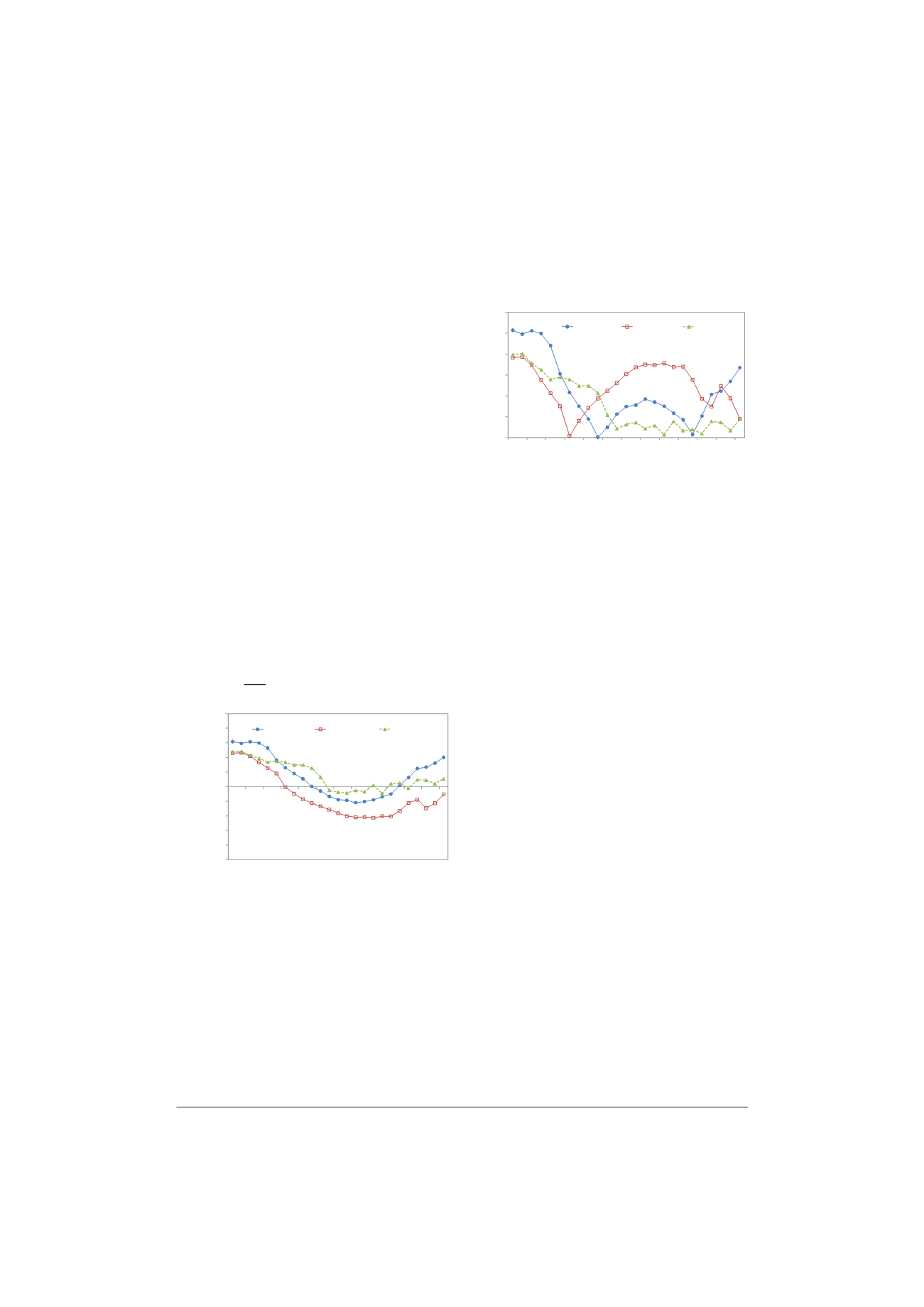
2011 International Conference on Alternative Energy in Developing Countries and Emerging Economies
- 297 -
the linear line. The results showed that the slopes were
positive as the results in Fig. 12(a) to 12(c). In summer,
the ETS could reduce the outflow air temperature as
much as possible with the longest duration. For winter
and rainy seasons, the ability of temperature reduction
was less than that in the summer, because the GH
temperatures were less than the soil temperature
especially in the morning and evening. Therefore the ETS
became a heating system and had a shorter cooling time
than the operation in summer. However, this is not
important because we consider only the condition
appropriate to specific plant.
In addition to analysis of all climates previously, in
fact, the outflow temperature should be close to the soil
temperature. But the outflow temperature throughout the
day was higher than soil temperatures as a result of heat
from the blower and absorbed solar radiation. When
considering the characteristic of regression lines at the
inflow temperature being equal to soil temperature, it was
found that the intersection on y-axis was approximately at
3.5
o
C. This value was caused by an unwanted heat from
blower to the air flow therefore the cooling system should
be modified in the future work.
From the variation of temperature and relative
humidity changes in various climate of Chiang Mai, we
know that the ETS could be a cooling system for daytime
thus the ability of ETS in each climate is analyzed. The
analysis includes the heat removal and coefficient of
performance (COP). COP is an effective indicator in the
thermal system. The value is in scalar as the ratio of
removable heat
ܳ
௨௧
to energy consumption
ܹ
which is
defined as
ܥ
ܱܲ
=
ொ
ೠ
ௐ
(1)
-1.00
-0.80
-0.60
-0.40
-0.20
0.00
0.20
0.40
0.60
0.80
1.00
6:00AM
7:00AM
8:00AM
9:00AM
10:00AM
11:00AM
12:00PM
1:00PM
2:00PM
3:00PM
4:00PM
5:00PM
6:00PM
Heat Exchange
(kW)
Time (hr)
23-Dec-09
04-May-10
08-Aug-10
Fig. 13. The variation of heat changes for model GH in winter,
summer, and rainy season.
Fig. 13 shows the variations of heat removal of the
EST in winter, summer, and rainy season. From 6 a.m. to
6 p.m. inside GH received heat from the soil (positive
value) and transferred heat to the underground (negative
value). Regarding the heat transfer to the soil it showed
that the ETS utilization in the summer (May 4, 2010)
would be able to remove heats more than those in winter
(December 23, 2009) and the rainy seasons. (August 8,
2010). The ETS could remove the exceeding heat starting
at 9 a.m. which ranged from 0.1 - 0.43 kW, while in
winter and rainy seasons in the ranges of 0.06 - 0.22 kW
and 0.02 - 0.09 kW, respectively. In the morning and
evening, the ETS would receive heat of 0 - 0.6 kW from
the soil resulting in high inside temperature and no
cooling.
0
1
2
3
4
5
6
6:00AM
7:00AM
8:00AM
9:00AM
10:00AM
11:00AM
12:00PM
1:00PM
2:00PM
3:00PM
4:00PM
5:00PM
6:00PM
Coefficient of Performance
Time (hr)
23-Dec-09 04-May-10 08-Aug-10
Fig. 14. The coefficient of performance of model GH in winter,
summer, and rainy season.
Fig. 14 presents the COP of model GH in winter,
summer, and rainy season. The cooling COP in a typical
day of summer was highest during daytime. The values
changed from 0.07 - 3.56. The next lower rank was in
winter which the COP was in the range of 0.49 - 1.84 and
the lowest COP was in the rainy season about 0.19 - 0.77.
In another operation time, COP of heating had a
maximum value in the range of 4 - 5, especially in the
morning of a typical day of winter.
IV. C
ONCLUSIONS
The cooling study of the earth tube system in different
climates of Chiang Mai showed that the ETS has low
potential for controlling GH temperature when compared
with the conventional plastic GH without cooling. Even
though during daytime, the accumulative heat inside GH
is very high but the ETS could transfer less heat to the
underground in terms of 2 - 4
o
C GH temperature
reduction. However, the inside temperature is also too
high for the some plant growth. In order to enhance the
efficiency of cooling, the ETS has to be improved for the
air supply system. Alternative ways are to use other
passive cooling methods together with the ETS for
example:
natural
ventilation,
shading
material,
evaporative cooling and etc. Use of ambient air cooler
than GH may also be reconsidered. However, suitable
operating time in each season may be appropriate for
some specific plants.
A
CKNOWLEDGMENT
I would like to thank the Commission on Higher
Education, Thailand for supporting by grant fund under
the program Strategic Scholarships for Frontier Research
Network for the Ph.D. Program Thai Doctoral degree for
this research. I would like to thank Department of Plant
Science and Natural Resources, Faculty of Agriculture,
Chiang Mai University for providing experimental


